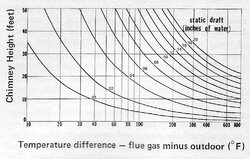I am helping a friend choose and install a new Vermont Castings Encore non-cat in his home. We are in west TN at about 300 feet above sea level. I have about 15 years experience burning wood, for 14 years with an old smoke dragon stove, and the last season with a VC Defiant non-cat. My Defiant has an 8 inch uninsulated pipe that goes up to the 10' ceiling where it feeds into an 8 inch insulated pipe for another 10 feet. Our stove functions very well. I have observed that it will draw like crazy when it is really cold (10-20 degrees) and it will get a little lazy at 50 or 60 degrees. It really seems to self adjust its draw to the outside temperature. I do not have an outside air intake.
The VC encore comes standard with an 8" collar, but you can order it with a 6" collar. It is supposed to produce 50,000 BTU. My friend will be putting his stove on the hearth of what was a gas log fireplace. The fireplace has do damper and has a 12x12 terra cotta flue inside brick. His Encore will have a short section of non-insulated pipe running horizontal for 12-18 inches and then it will run into 18 feet of stainless double wall insulated pipe. Tne dealer says the Encore was originally tested with a 8 inch pipe. It is my understanding that all of the EPA tests were done with a 15 foot pipe. The dealer says a 6" pipe x 20 feet will draw very well unless you plan on using the stove with the doors open, which my friend does not plan on doing.
He checked with another dealer and the second dealer recommended an 8" insulated pipe.
He is planning on using a high quality, well insulated pipe that comes in 3 and 4 foot sections.
The research I have done seems to indicate that you need a certain amount of velocity of hot gasses going up the pipe.
Is there a scientific way to determine the size of the flue pipe?
The VC encore comes standard with an 8" collar, but you can order it with a 6" collar. It is supposed to produce 50,000 BTU. My friend will be putting his stove on the hearth of what was a gas log fireplace. The fireplace has do damper and has a 12x12 terra cotta flue inside brick. His Encore will have a short section of non-insulated pipe running horizontal for 12-18 inches and then it will run into 18 feet of stainless double wall insulated pipe. Tne dealer says the Encore was originally tested with a 8 inch pipe. It is my understanding that all of the EPA tests were done with a 15 foot pipe. The dealer says a 6" pipe x 20 feet will draw very well unless you plan on using the stove with the doors open, which my friend does not plan on doing.
He checked with another dealer and the second dealer recommended an 8" insulated pipe.
He is planning on using a high quality, well insulated pipe that comes in 3 and 4 foot sections.
The research I have done seems to indicate that you need a certain amount of velocity of hot gasses going up the pipe.
Is there a scientific way to determine the size of the flue pipe?


